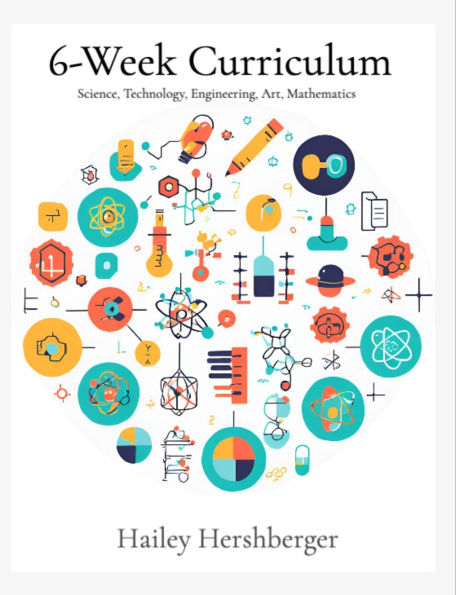6-Week STEAM Curriculum
The STEAM Curriculum offers a comprehensive, hands-on learning experience that introduces students to the principles of Science, Technology, Engineering, Arts, and Mathematics (STEAM), fostering innovation and problem-solving skills. Over six weeks, participants engage in a series of structured activities and challenges designed to deepen their understanding of STEAM concepts, while also encouraging creativity and collaboration.
Week 1: Introduction to STEAM and Design Thinking
Students begin by exploring the fundamentals of STEAM, including key concepts and potential career paths. They are introduced to the Design Thinking process, a problem-solving approach that emphasizes empathy, brainstorming, and iteration. By working in teams, students participate in a design challenge, identifying real-world problems and developing innovative solutions using design thinking principles.
Week 2: Science and Technology
This week delves into essential scientific principles such as physics, chemistry, and biology. Students also explore different technologies like coding, robotics, and electronics. Through hands-on activities, they build and program robots, create circuits, and conduct engaging science experiments, applying theoretical knowledge to practical scenarios.
Week 3: Engineering and Math
Participants are introduced to various engineering fields (e.g., civil, mechanical, aerospace) and engage in math activities and games that reinforce important concepts such as geometry, algebra, and statistics. The highlight of the week is a design challenge, where students collaborate to design and construct a structure using engineering principles, further developing critical thinking and teamwork.
Week 4: Arts and Creativity
This week emphasizes the creative side of STEAM, exploring different art forms such as drawing, painting, sculpture, and music. Students learn how creativity intersects with STEAM and work in teams to develop a creative project, such as a multimedia presentation or performance, blending the arts with scientific and technological themes.
Week 5: Computer Science and Data Science
Students are introduced to fundamental computer science concepts (e.g., programming, web development) as well as data science, which includes data analysis and visualization. Through practical exercises, they learn how to code websites, write programs, and analyze data, applying digital skills to solve real-world problems.
Week 6: Culminating Project
In the final week, students put all their acquired skills to the test. Working in teams, they identify a real-world problem and use their STEAM knowledge to develop and prototype an innovative solution. The camp culminates with final presentations, where students showcase their projects and solutions to a panel of judges or the larger community, celebrating their accomplishments.
This STEAM Curriculum offers a unique blend of creativity, innovation, and critical thinking, equipping students with the tools they need for future success in STEAM fields.
6-Week STEAM Curriculum
The STEAM Curriculum offers a comprehensive, hands-on learning experience that introduces students to the principles of Science, Technology, Engineering, Arts, and Mathematics (STEAM), fostering innovation and problem-solving skills. Over six weeks, participants engage in a series of structured activities and challenges designed to deepen their understanding of STEAM concepts, while also encouraging creativity and collaboration.
Week 1: Introduction to STEAM and Design Thinking
Students begin by exploring the fundamentals of STEAM, including key concepts and potential career paths. They are introduced to the Design Thinking process, a problem-solving approach that emphasizes empathy, brainstorming, and iteration. By working in teams, students participate in a design challenge, identifying real-world problems and developing innovative solutions using design thinking principles.
Week 2: Science and Technology
This week delves into essential scientific principles such as physics, chemistry, and biology. Students also explore different technologies like coding, robotics, and electronics. Through hands-on activities, they build and program robots, create circuits, and conduct engaging science experiments, applying theoretical knowledge to practical scenarios.
Week 3: Engineering and Math
Participants are introduced to various engineering fields (e.g., civil, mechanical, aerospace) and engage in math activities and games that reinforce important concepts such as geometry, algebra, and statistics. The highlight of the week is a design challenge, where students collaborate to design and construct a structure using engineering principles, further developing critical thinking and teamwork.
Week 4: Arts and Creativity
This week emphasizes the creative side of STEAM, exploring different art forms such as drawing, painting, sculpture, and music. Students learn how creativity intersects with STEAM and work in teams to develop a creative project, such as a multimedia presentation or performance, blending the arts with scientific and technological themes.
Week 5: Computer Science and Data Science
Students are introduced to fundamental computer science concepts (e.g., programming, web development) as well as data science, which includes data analysis and visualization. Through practical exercises, they learn how to code websites, write programs, and analyze data, applying digital skills to solve real-world problems.
Week 6: Culminating Project
In the final week, students put all their acquired skills to the test. Working in teams, they identify a real-world problem and use their STEAM knowledge to develop and prototype an innovative solution. The camp culminates with final presentations, where students showcase their projects and solutions to a panel of judges or the larger community, celebrating their accomplishments.
This STEAM Curriculum offers a unique blend of creativity, innovation, and critical thinking, equipping students with the tools they need for future success in STEAM fields.

6-Week Curriculum: S.T.E.A.M
100
6-Week Curriculum: S.T.E.A.M
100Related collections and offers

Product Details
| ISBN-13: | 9798330389636 |
|---|---|
| Publisher: | Hailey Hershberger |
| Publication date: | 07/01/2023 |
| Sold by: | Barnes & Noble |
| Format: | eBook |
| Pages: | 100 |
| File size: | 1 MB |
